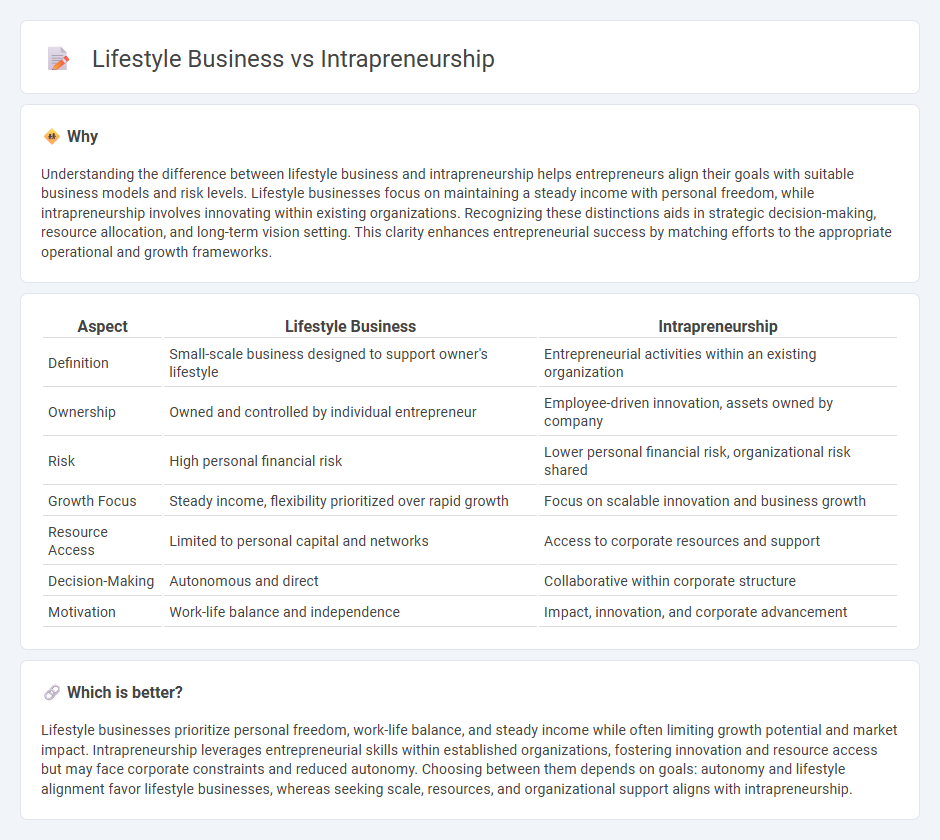
Lifestyle businesses prioritize personal freedom and work-life balance while generating steady income through niche markets or passions. Intrapreneurship involves employees driving innovation and new ventures within established companies, combining entrepreneurial spirit with corporate resources. Explore the distinctions to determine which path best aligns with your career goals and aspirations.
Why it is important
Understanding the difference between lifestyle business and intrapreneurship helps entrepreneurs align their goals with suitable business models and risk levels. Lifestyle businesses focus on maintaining a steady income with personal freedom, while intrapreneurship involves innovating within existing organizations. Recognizing these distinctions aids in strategic decision-making, resource allocation, and long-term vision setting. This clarity enhances entrepreneurial success by matching efforts to the appropriate operational and growth frameworks.
Comparison Table
| Aspect | Lifestyle Business | Intrapreneurship |
|---|---|---|
| Definition | Small-scale business designed to support owner's lifestyle | Entrepreneurial activities within an existing organization |
| Ownership | Owned and controlled by individual entrepreneur | Employee-driven innovation, assets owned by company |
| Risk | High personal financial risk | Lower personal financial risk, organizational risk shared |
| Growth Focus | Steady income, flexibility prioritized over rapid growth | Focus on scalable innovation and business growth |
| Resource Access | Limited to personal capital and networks | Access to corporate resources and support |
| Decision-Making | Autonomous and direct | Collaborative within corporate structure |
| Motivation | Work-life balance and independence | Impact, innovation, and corporate advancement |
Which is better?
Lifestyle businesses prioritize personal freedom, work-life balance, and steady income while often limiting growth potential and market impact. Intrapreneurship leverages entrepreneurial skills within established organizations, fostering innovation and resource access but may face corporate constraints and reduced autonomy. Choosing between them depends on goals: autonomy and lifestyle alignment favor lifestyle businesses, whereas seeking scale, resources, and organizational support aligns with intrapreneurship.
Connection
Lifestyle businesses focus on aligning entrepreneurial ventures with personal values and desired work-life balance, fostering intrinsic motivation and sustainable growth. Intrapreneurship encourages innovation within established organizations by empowering employees to act like entrepreneurs, driving internal value creation and adaptability. Both concepts emphasize autonomy, creativity, and purpose-driven initiatives to achieve meaningful and flexible professional fulfillment.
Key Terms
Innovation
Intrapreneurship drives innovation within established companies by empowering employees to develop new products, services, or processes that align with corporate goals and leverage existing resources. Lifestyle businesses prioritize personal freedom and steady income rather than disruptive innovation, often serving niche markets with limited growth aspirations. Discover more about how these business models impact innovation and growth strategies.
Autonomy
Intrapreneurship fosters autonomy within an established company, empowering employees to innovate and lead projects while benefiting from corporate resources and stability. Lifestyle businesses prioritize personal freedom and flexibility, allowing owners to design work around their preferred living standards without the pressure of rapid growth or external investment. Explore how autonomy shapes the strategic goals and daily operations of both intrapreneurs and lifestyle entrepreneurs to determine the best fit for your ambitions.
Risk-taking
Intrapreneurship involves employees taking calculated risks within a company to innovate and drive growth, while lifestyle businesses typically minimize risk to prioritize steady income and personal freedom. Risk-taking in intrapreneurship is strategic and backed by organizational resources, contrasting with the cautious approach of lifestyle entrepreneurs who avoid high-stakes ventures. Explore deeper insights into how risk profiles shape each business model's success and sustainability.
Source and External Links
What is intrapreneurship, and how can you cultivate it at your company - Intrapreneurship involves individuals within established companies who innovate and drive growth by applying entrepreneurial skills without bearing the financial risk of starting a business, fostering new ideas and improvements internally.
Intrapreneurship - Wikipedia - Defined as behaving like an entrepreneur inside a large organization, intrapreneurs take direct responsibility for turning ideas into innovations through risk-taking and creativity, benefiting both themselves and the company.
Why focus on Intrapreneurship? - Intrapreneurship is the entrepreneurial mindset and behavior used within existing organizations to identify opportunities and create positive changes, which can be cultivated and taught to enhance organizational success and adaptability.
 dowidth.com
dowidth.com